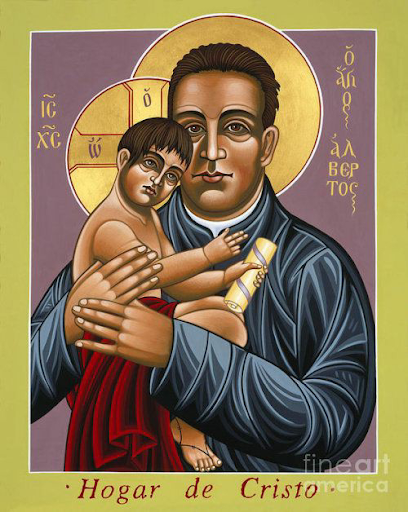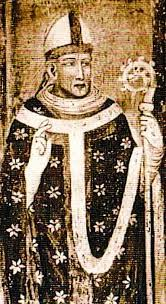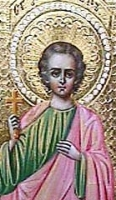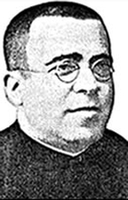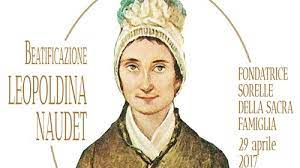St. Julius
Feastday: August 19
Death: 190
Saint Julius was a Roman senator and martyr who was killed in 190. He is recorded by Saints Eusebius and Pontian, who were both early Christian writers.
Julius was converted to Christianity by Saint Eusebius, and he subsequently distributed his wealth among the poor. When the emperor Commodus heard of this, he had Julius arrested and handed him over to the military commander Vitellius. Vitellius imprisoned Julius in a dungeon for three days, after which he was beaten to death.
The body of Saint Julius was taken and buried by Saint Eusebius and his colleagues on 19 August near the Via Aurelia. His feast day is celebrated on that day.
Saint John Eudes
புனிதர் ஜான் யூட்ஸ்
கத்தோலிக்க குரு/ சபை நிறுவனர்:
பிறப்பு: நவம்பர் 14, 1601
ரி, நார்மண்டி, ஃபிரான்ஸ் அரசு
இறப்பு: ஆகஸ்டு 19, 1680 (அகவை 78)
சேன், ஃபிரான்ஸ் அரசு
ஏற்கும் சமயம்:
ரோமன் கத்தோலிக்கத் திருச்சபை
முக்திபேறு பட்டம்: ஏப்ரல் 25, 1909
திருத்தந்தை பத்தாம் பயஸ்
புனிதர் பட்டம்: மே 31, 1925
திருத்தந்தை பதினோறாம் பயஸ்
நினைவுத் திருநாள்: ஆகஸ்ட் 19
பாதுகாவல்:
இயேசு மரியாள் (யூடிஸ்ட்) தொண்டு நிறுவனம் (Eudists)
கருணை அன்னை சபை (Order of Our Lady of Charity)
பே-கோமியு மறைமாவட்டம் (Diocese of Baie-Comeau)
மறைப்பணியாளர்கள் (Missionaries)
புனித ஜான் யூட்ஸ், ஓரு ஃபிரெஞ்ச் மறைப்பணியாளரும், கத்தோலிக்க குருவும், “இயேசு மற்றும் மரியாளின் தொண்டு நிறுவனம் - யூடிஸ்ட்” (Congregation of Jesus and Mary - Eudists) மற்றும் “கருணை அன்னை சபை” (Order of Our Lady of Charity) ஆகியவற்றின் நிறுவனரும் ஆவார்.
ஃபிரான்ஸ் நாட்டின் “நார்மண்டி” (Normandy) என்ற இடத்தினருகேயுள்ள “ரி” (Ri) எனும் கிராமத்தில், 1601ம் ஆண்டு பிறந்த இவருடைய பெற்றோர், “ஐசாக் யூட்ஸ்” மற்றும் “மார்த்தா கோர்பின்” (Isaac Eudes and Martha Corbin) ஆவர். ஃபிரான்ஸின் வடமேற்கு பிராந்தியமான “சேன்” (Caen) எனுமிடத்தில், இயேசு சபையினரிடம் (Jesuits) கல்வி கற்ற இவர், 1623ம் ஆண்டு, மார்ச் மாதம் 25ம் தேதி, “ஃபிரெஞ்ச் ஒரேடரி” (Oratorians) என்றழைக்கப்படும் “இயேசு மற்றும் மாசற்ற மரியாளின் ஒற்றுமை” (Congregation of the Oratory of Jesus and Mary Immaculate) எனும் சபையினருடன் இணைந்தார். இவர், “பிரெஞ்ச் ஆன்மீக பள்ளியின்” (French School of Spirituality) உறுப்பினர் ஆவார். பிரெஞ்ச் ஆன்மீக பள்ளி என்பது, ஒரு அமைப்பு அல்லது தத்துவம் மட்டுமேயல்ல. மாறாக, அது ஒரு ஆவிக்குரிய உயர்ந்த கிறிஸ்தவ அணுகுமுறையும், உணர்வுகள் மூலம் வகைப்படுத்தப்படும் ஆராதனையும், இயேசுவுடனான தனிப்பட்ட உறவும், தூய ஆவியின் மறு கண்டுபிடிப்புமாகும்.
யூட்ஸ், 1625ம் ஆண்டு, டிசம்பர் மாதம், 2௦ம் தேதி குருத்துவ அருட்பொழிவு பெற்றார். குருத்துவம் பெற்றவுடனேயே நோயுற்ற இவர், கிட்டத்தட்ட ஒரு வருடம் வரை படுக்கையிலேயே இருந்தார். 1627 மற்றும் 1631 ஆகிய வருடங்களில் ஃபிரான்ஸ் முழுதும் பிளேக் எனும் கொள்ளை நோயால் தாக்குண்டபோது, தமது உடல்நிலையையும் பொருட்படுத்தாது பிளேக் நோயால் தாக்குண்டவர்களுக்கு சேவை புரிய நார்மண்டி (Normandy) சென்றார். நோயால் பாதிக்கப்பட்ட மக்களுக்காக நற்கருணை ஆராதனைகள் நிகழ்த்தினார். இறந்து போனவர்களை அடக்கம் செய்வதில் உதவிகள் செய்தார்.
தமது 32 வயதில் பங்கு மறைப்பணியாளராக பொறுப்பேற்ற இவர், “நார்மண்டி, ல்லெ-டே-ஃபிரான்ஸ், பர்கண்டி மற்றும் பிரிட்டனி” (Normandy, Ile-de-France, Burgundy and Brittany) ஆகிய பகுதிகளில் நூற்றுக்கும் மேற்பட்ட பிரசங்கங்கள் ஆற்றினார்.
தமது பங்கு மறைப்பணிகளின்போது, வாழ்வில் வழி தவறிப்போன விபச்சாரப் பெண்களால் மிகவும் கலங்கினார். தமது பாவ வாழ்க்கையிலிருந்து மீண்டு வாழ விரும்பிய விபச்சார பெண்களுக்கு அடைக்கலம் தருவதற்காக, 1641ம் ஆண்டு, “கருணையின் அடைக்கல அன்னை” (Order of Our Lady of Charity of the Refuge) எனும் சபையை நார்மண்டியிலுள்ள “சேன்” (Caen) நகரில் நிறுவினார். “அன்னை மரியாளின் திருவருகை” (Visitation) சபையைச் சேர்ந்த மூன்று அருட்சகோதரியர் இவரது உதவிக்காக வந்தனர். கி.பி. 1644ம் ஆண்டு, சேன் நகரில் “கருணையின் அன்னை” (Our Lady of Charity) என்ற பெயரில் ஒரு இல்லம் தொடங்கினார். இவர்களது சபை, கி.பி. 1666ம் ஆண்டு, ஜனவரி மாதம், 2ம் தேதியன்று, திருத்தந்தை “ஏழாம் அலெக்சாண்டர்” (Pope Alexander VII) அவர்களால் அங்கீகரிக்கப்பட்டது.
கர்தினால் “ரிசெளியு” (Cardinal Richelieu) மற்றும் பல ஆயர்களின் ஆதரவுடன் “யூடிஸ்ட்ஸ்” என்றழைக்கப்படும் “இயேசு மற்றும் மரியாளின் தொண்டு நிறுவனத்தை” (Congregation of Jesus and Mary (Eudists) கி.பி. 1643ம் ஆண்டு, மார்ச் மாதம், 25ம் தேதியன்று, சேன் நகரில் நிறுவினார். இந்நிறுவனம், குருக்களின் கல்வி மற்றும் பங்கு மறைப்பணி ஆகியவற்றுக்கே அர்ப்பணிக்கப்பட்டதாகும்.
யூட்ஸ், இயேசுவின் திருஇருதய பக்தியையும், மரியாளின் மாசற்ற இருதய பக்தியையும் ஊக்குவித்து வளர்த்தார். மறைப்பணியின்போது, பல தியானங்கள் கொடுப்பதன் வழியாக பலருக்கு ஆறுதல்படுத்தும் பணியையும், குணமளிக்கும் பணியையும், நற்செய்திப் பணியையும் ஆற்றினார். இதன் வழியாக எண்ணிடலங்கா மக்களை இறைவழி செல்ல வழிகாட்டினார்.
நற்கருணையாண்டவர் பக்தி:
ஃபிரெஞ்ச் பள்ளி மற்றும் “புனிதர் ஃபிரான்சிஸ் டே சலேஸ்” (Saint Francis de Sales) ஆகியோரின் படிப்பினைகளின் செல்வாக்கினாலும் கடவுளின் அன்பினைப் பற்றிய உபதேசங்களாலும் ஈர்க்கப்பட்ட யூட்ஸ், நற்கருணையாண்டவரின் பக்தியில் ஆழ்ந்த ஈடுபாடு கொண்டிருந்தார். சேன் நகரிலுள்ள குருத்துவ சிற்றாலயங்களை இயேசுவின் திருஇருதயத்திற்கு அர்ப்பணித்தார். யூட்ஸ், பல்வேறு செபங்களையும் செபமாலைகளையும் திருஇருதயத்திற்காக இயற்றினார். இவர் எழுதிய (Le Cœur Admirable de la Très Sainte Mère de Dieu) என்ற புத்தகம், திருஇருதயங்களின் பக்திக்காக எழுதப்பட்ட முதல் புத்தகமாகும். இயேசு மற்றும் மரியாளின் ஆத்மபலம் கொண்ட திருஇருதயங்களின் பக்தியை கற்பித்தார்.
அருட்தந்தை யூட்ஸ், பல்வேறு புத்தகங்களை எழுதினர். அவற்றுள் சில பின்வருமாறு:
1. இயேசுவின் வாழ்க்கை மற்றும் அரசு. (கி.பி. 1637)
(The Life and Kingdom of Jesus, 1637 AD)
2. திருமுழுக்கு மூலம் மனிதனுக்கும் இறைவனுக்கும் இடையேயான ஒப்பந்தம். (கி.பி. 1654)
(Contract of Man with God Through Holy Baptism, 1654 AD)
3. நல்ல பாவங்களை ஒப்புக்கொள்பவர் (கி.பி. 1666)
(The Good Confessor, 1666 AD)
அருட்தந்தை ஜான் யூட்ஸ், கி.பி. 1680ம் ஆண்டு, ஆகஸ்ட் மாதம், 19ம் நாள், சேன் (Caen) நகரில் மரித்தார்.
Also known as
Jean Eudes
Profile
Farmer's son who attended the Jesuit college at Caen, France at age 14. Joined the Congregation of the Oratory of France. Studied at Paris and Aubervilliers in France. Priest. Ministered to plague victims. Missionary and preacher, working well over 100 missions. Worked against Jansenism. Established seminaries. Founded the Congregation of Jesus and Mary Eudists on 25 March 1643 to promote virtuous secular parochial clergy not bound by vows, but dedicated to improving the clergy through seminaries and missions; due to opposition by Oratorians and Jansenists, he never obtained papal approval. Founded the Sisters of Our Lady of Charity who worked for the welfare of penitent women. Author of the liturgical devotion of the Sacred Hearts of Jesus and Mary.
Born
14 November 1601 at Ri, Normandy, France
Died
19 August 1680 at Caen, Normandy, France
Canonized
31 May 1925 by Pope Pius XI
Patronage
diocese of Baie-Comeau, Québec
Representation
priest with or presenting the Sacred Hearts of Jesus and Mary
Blessed Jordan of Pisa
Profile
Joined the Dominicans at Pisa, Italy in 1280. Educated at the University of Paris, France. Lector at Sainta Maria Novella church in Florence, Italy in 1305. Noted preacher in and around Florence. Founded the Confraternity of the Holy Redeemer at Pisa. Professor of theology at Saint James Friary, Paris in 1311. A visionary, Jordan had two great devotions - Our Lady and Saint Dominic de Guzman.
Made a scientific study of the use of preaching as an apostolic tool. Considered a daring innovator for extending the use of vernacular Italian as a beautiful, musical language of evangelization; his use of Italian and Tuscan helped lead to the modern Italian language. Knew the breviary, missal, most of the Bible (with commentary), and the second part of the Summa Theologica by heart. Quick to state that learning alone can never make a preacher; it needed a holiness of life.
Born
c.1255 at Pisa, Italy
Died
• 19 August 1311 at Piacenza, Italy of natural causes while on his way to teach in Paris, France
• relics venerated at the church of Saint Catalina at Pisa, Italy
Beatified
• 23 August 1833 (cultus confirmed) by Pope Gregory XVI
• 1838 (beatification) by Pope Gregory XVI
Prayers
God of holiness, by the integrity of his life and gentle manner you made Blessed Jordan a fitting minister to preach the gospel. By following his example may we generously strive to serve you through service to our neighbor and so gain the fruit of an everlasting reward. We ask this through our Lord Jesus Christ, your Son, who lives and reigns with you and the Holy Spirit, one God, for ever and ever. - General Calendar of the Order of Preachers
Saint Sebaldus
Also known as
Sebald, Sinibaldo, Siward
Profile
Son of a Danish chieftain who had settled in England. Missionary in the Reichswald area of Germany, working with Saint Willibald of Eichstatt, Saint Winibald and Saint Boniface. Popular preacher who converted many, he later retired near Nuremburg, Germany where he would alternate life as a prayerful hermit and then a zealous evangelist.
A number of miracle stories are told about him
he converted stones to bread and water to wine to feed his fellow missionaries
• he burned icicles as firewood in the dead of winter to keep the poor from freezing
• when he was being heckled by a profane blasphemer, Sebaldus prayed, and the earth opened up to swallow the pagan; as he fell into the earth, the heckler asked for forgiveness; the earth spat him back out
• when a poor peasant was blind by his lord, Sebaldus restored the man's missing eyes by praying over him
Born
probably in England
Died
c.770
Patronage
• against cold weather
• Bavaria, Germany
• Nuremberg, Germany
Blessed Gregorio Martos Muñoz
Profile
Born to a farm family who had migrated from Válor, Spain to Argentina in search of a better life; Gregorio was baptized at the age of nine days. When the boy was ten years old, the family returned to Spain. When he was old enough, Gregorio studied at the seminary in Granada, and was such an able student that he graduated early, and served as a teacher before ordination. Ordained a priest in the archdiocese of Granada in 1933. As a parish priest, he was known as a gentle pastor who lived a life of poverty, and cared deeply about the sacramental life for the poor.
Father Gregorio was arrested by anti–Catholic forces at the start of the Spanish Civil War, and was imprisoned in Dalias, Berja and El Ejido prisons. His captors tried to get him to renounce his faith, and at one point tried to get him to desecrate a medal of the Virgin Mary; he swallowed it to get it away from them. They eventually gave up on changing him, and murdered him instead. Martyr.
Born
3 April 1908 in Chilecito, La Rioja, Argentina
Died
19 August 1936 in Albufera de Adra, Almería, Spain
Beatified
• 25 March 2017 by Pope Francis
• beatification celebrated in the Palacio de Exposiciones y Congresos de Aguadulce, Almería, Spain, presided by Cardinal Angelo Amato
Saint Magnus of Anagni
Also known as
• Magno di Anagni
• Magnus of Fabrateria Vetus
• Magnus of Trani
Profile
Son of Apollonius, a poor farmer. As a young man he worked as a shepherd to support his family and neighbors who were poorer than himself. Convert, baptized with his father by Bishop Redemptus of Trani, Italy. Magnus succeeded him as bishop of Trani, chosen by popular acclaim of the local laity and clergy. Evangelized in Fondi, Aquino, and Anagni. During the persecutions of Tarquinius, Magnus fled to Rome, Italy, but tried to secretly return to Trani. Found in a cave near Fondi by imperial soldiers. Martyr.
Born
2nd century at Trani, Italy
Died
• beheaded near Fabrateria Vetus, Latium (modern Ceccano, Italy)
• buried in Fondi, Italy
• relics translated from Fondi to Veroli, Italy
• relics translated to the cathedral in Anagni, Italy after a wealthy but superstitious Muslim had some horses die when near them in Veroli
Patronage
• Anagni-Alatri, Italy, diocese of
• Anagni, Italy
• Colle San Magno, Italy
Saint Louis of Toulouse
தூலூஸ் நகர்ப் புனித லூயிஸ்
(1274-1297)
இவர் இத்தாலியைச் சார்ந்தவர். இவரது தந்தை நேப்பிள்ஸை ஆண்டு வந்த இரண்டாம் சார்லஸ் என்பவராவார். இவர் ஹங்கேரி நாட்டைச் சார்ந்த புனித எலிசபெத்தின் நெருங்கிய உறவினரும் கூட.
வசதியான குடும்பத்தில் பிறந்தாலும், சிறிதும் ஆடம்பரமில்லாமல் வாழ்ந்து வந்த இவர், பிரான்சிஸ்கன் சபையில் சேர்ந்து தனது இருபத்து மூன்றாம் வயதில் துறவியானார்.
பின்னர் தூலூஸ் நகரின் ஆயரான இவர், இறைப்பணியை மிகச் சிறப்பாகவும், அதே நேரத்தில் தாழ்ச்சியோடும் செய்து வந்தார். இந்நிலையில் இவர் ஆயரான ஆறாவது மாதத்தில் திடீரென நோய்வாய்ப்பட்டு இறைவனடி சேர்ந்தார்.
இவருக்கு 1317 ஆம் ஆண்டு திருத்தந்தை இருபத்து இரண்டாம் யோவானால் புனிதர் பட்டம் கொடுக்கப்பட்டது
Also known as
• Louis of Anjou
• Ludwig of...
Profile
Born to the nobility, the son of Charles II of Anjou, king of Naples. Great-nephew of Saint Louis IX, and of Saint Elizabeth of Hungary. Grew up in Provence (in modern France). Spent seven years as a hostage for his father at Barcelona and Tarragona in Spain. Ordained at age 23. Friar Minor. Reluctant bishop of Toulouse, France for the last six months of his life.
Born
February 1274 at Nocera, Italy
Died
• 19 August 1297 at Brignolles, Italy of natural causes
• some relics in Valencia, Spain
Canonized
7 April 1317 by Pope John XXII
Patronage
• Valencia, Spain
• Mission San Luis Obispo de Tolosa, California
Saint Ezekiel Moreno y Díaz
Also known as
Ezequiel Moreno y Díaz
Profile
Raised in a pious family in a pious town. Joined the Augustinian Recollects on 21 September 1864 at Montegudo, Navarra, Spain. Prior of his monastery. Ordained at Manila, Philippines on 3 June 1871, and became a well-known missionary. Vicar apostolic of Casanare and bishop of Pinara, Colombia on 23 October 1893. Bishop of Pasto, Columbia on 2 December 1893. Noted for his generous charity to the faithful of his diocese.
Born
9 April 1848 at Alfaro, Tarazona, Spain
Died
• 19 August 1906 at Montegudo, Navarra, Spain of cancer of the palatte
• the miracles related to his beatification and canonization involve cures of cancer patients
Canonized
11 October 1992 by Pope John Paul II at Santo Domingo, Dominican Republic
Blessed Leo II of Cava
Profile
Benedictine monk. Fourteenth abbot of the monastery of Cava de Tirreni in Campania, Italy, chosen on 25 January 1268, consecrated on 5 February 1268, granted a bull of confirmation by Pope Gregory X and served for 27 years. Partipated in the Council of Lyons in 1274, and used the trip to visit the abbey of Cluny and learn from the Cluniac monks. Built a new church and new cloister at his monastery, and had many new manuscripts copied for its library.
Born
1239
Died
• 19 August 1295 at the Cava dei Tirreni monastery in Campania, Italy
• buried before the main altar in the abbey church
• relics re-interred in 1675 into a wall of the Arsicia cave, the first hermitage of the founder of Cava dei Tirreni
Beatified
16 May 1928 by Pope Pius XI (cultus confirmation)
Sarah the Matriarch
Also known as
Sari, Sarai, Sara
Profile
Jewish Old Testament Matriarch. Wife of the Patriarch Abraham. A convert from paganism, she was the first female convert to the faith of Abraham. Nomad in the desert of Canaan. When she was aged 90, she heard angels say she would finally become a mother. She laughed at the idea, and when her son was born, she named him Isaac from the word for laughter.
Died
of natural causes at age 127
Pope Saint Sixtus III
Also known as
Xystus III
Profile
Chosen 44th pope in 432. Approved the results of the Council of Ephesus. Corresponded extensively with Saint Augustine of Hippo. Fought Nestorianism and Pelagianism. Restored several Roman basilicas including Saint Peter's and Saint John Lateran. Defended the supremacy of the pope over local bishops, and over Illyria which the emperor wanted to transfer to the control of Constantinople.
Born
at Rome, Italy
Papal Ascension
31 July 432
Died
18 August 440 in Rome, Italy of natural causes
Saint Magino of Tarragona
Also known as
Magi, Magin, Maginus
Profile
Born to the Gallic nobility of Burgundy (in modern France), he was orphaned at an early age. Hermit on Mount Brufagaña for 30 years. Had the gift of healing by prayer, which he did for the governor of Tarragona, Spain. Imprisoned, tortured and martyred in the persecutions of Diocletian.
Died
beheaded with a sickle in c.304 in Tarragona, Spain
Patronage
Tarragona, Spain
Blessed Hugh Green
Also known as
Ferdinand Brooke
Additional Memorial
29 October as one of the Martyrs of Douai
Profile
Educated at Peterhouse, Cambridge, England. Convert to Catholicism. Studied for the priesthood, and ordained at Douai, France in 1612. Worked with covert Catholics at Dorset, England during a period of persecution. One of the Martyrs of England and Wales.
Born
London, England
Died
hanged on 19 August 1642 at Dorchester, Dorset, England
Beatified
15 December 1929 by Pope Pius XI
Blessed Angelo of Acquapagana
Also known as
Angel
Additional Memorials
• 19 October in Acquapagana, Italy)
• Sunday after the Feast of the Annunciation (local popular festival)
Profile
Monk at Valdicastro, Italy. Hermit, joining the Camaldolese c.1285 at the San Salvatore di Acquapagana hermitage and living in a nearby cave.
Born
1261
Died
• 1313 in Acquapagana, Piceno, Italy
• relics enshrined in the church of the territorial monastery of Montecavallo, Italy
Beatified
14 June 1846
Blessed Guerricus
Profile
Studied at Tournai, Belgium. Headmaster of the cathedral school at Tournai. Visited Clairvaux Abbey to see Saint Bernard and ended by staying there. Sent by Saint Bernard to be the first abbot at Igny, France in 1138. Prolific writer, some of whose works on ascetism were sometimes mistakenly attributed to Saint Bernard.
Born
c.1080 at Tournai, Belgium
Died
c.1155 at Igny, France of natural causes
Beatified
1889 by Pope Leo XIII (cultus confirmed)
Saint Andrew the Tribune
Also known as
Andrew Stratelates
Profile
Soldier. Tribune in the Greek army. Convert to Christianity, along with a number of his men, following a miraculous victory over the Persians. Martyred by Seleucus as a group for their new faith.
Died
• 300 at Mount Tarsus, Cilicia (in modern Turkey)
• relics of Andrew and some unnamed fellow soldier-martyrs are venerated in the church of Saint Vincent, Brioude, France
Saint Magnus of Cuneo
Also known as
• Magnus of the Theban Legion
• Magnus of Fabreteria Vetere
• Magno of...
Profile
One of the soldiers in the Theban Legion who survived their massacre. He fled to the mountains of the Piedmont region, and became an evangelist. When his reputation for holiness spread, the same persecutors who had killed his brothers in the Legion tracked him down. Martyr.
Saint Donatus of Mount Jura
Also known as
• Donatus of Sisteron
• Donato of....
Profile
Deacon. Priest. Following a pilgrimage to the tomb of Saint Martin of Tours, he retired from world to live as a hermit on Mount Jura near Sisteron, Provence (in modern France). Reported to have the gift of healing by prayer.
Born
Orleans, France
Died
c.535
Saint Flavien of Toulon
Profile
Sixth century Gothic soldier. He was a convert to Christianity, brought to the faith and baptized by Saint Cyprian of Toulon. Due to the persecutions of Arian Gothic king Aleric II, Flavien abandoned military life and fled to the island of Cépet, France where he lived the rest of his life as a hermit.
Blessed Michele Soriano
Profile
Mercedarian friar at the convent of Santa Maria degli Angeli in El Puig, Spain, known for his extreme piety, penance and asceticism.
Died
1604
Saint Timothy of Gaza
Profile
Bishop of Gaza, Palestine. Scourged, tortured and martyred by order of Urban, governor of Palestine, during the persecutions of Diocletian.
Died
burned alive in 304
Saint Magnus of Avignon
Profile
Married. Father of Saint Agricola of Avignon. Governor of Avignon, France. Widower. Monk at Lérins Abbey. Bishop of Lérins, France.
Born
Avignon, France
Died
660
Saint Guenninus
Profile
7th century bishop of Vannes, Brittany (in modern France).
Saint Guenninus was the 7th century bishop of Vannes, Brittany (in modern France). He is said to have been a missionary who converted many people to Christianity. He is also credited with founding the abbey of Saint-Guénolé in Landévennec.
Guenninus was born in Brittany in the early 6th century. He was educated by Saint Corentin, the first bishop of Quimper. After Corentin's death, Guenninus was elected bishop of Vannes. He served as bishop for many years and was known for his piety and his work to spread Christianity.
Died
relics at the cathedral of Vannes, Brittany (in modern France)
Saint Calminius
Also known as
Calmilius
Saint Calminius is also known as Calmilius. He was a hermit-founder who lived in France in the 6th or 7th centuries AD. He is credited with founding three abbeys: Mozac Abbey, in Puy-de-Dôme; Laguenne Abbey (near Tulle, Corrèze) and the abbey of Monastier-Saint-Chaffre. His feast day is August 19.
The name Calminius is derived from the Latin word "calmus," which means "calm." This is a fitting name for a saint who was known for his peaceful and serene demeanor.
Calminius was born in Auvergne, France. He was a devout Christian and he decided to live a life of solitude as a hermit. He eventually founded the abbey of Mozac, which became a major center of learning and culture in the Middle Ages.
Calminius is also known for his miracles. He is said to have cured the sick and raised the dead. He is also said to have been able to calm the storms and protect his followers from harm.
Calminius died in Mozac in the 7th century. His feast day is celebrated on August 19. He is a popular saint in France and he is often invoked for protection against storms and other natural disasters.
Died
c.690
Saint Elaphius of Châlons
Profile
Bishop of Châlons-sur-Marne, France. Envoy to Spain.
Saint Elaphius was the bishop of Châlons-sur-Marne, France in the 6th century. He was a friend of Saint Remigius, the bishop of Reims. Elaphius is said to have been a wise and compassionate leader who was dedicated to serving his flock.
Elaphius died in 532. His relics are still venerated in the cathedral of Châlons-sur-Marne.
Died
580 of natural causes in Spain while on a pilgrimage to the relics of Saint Eulalia of Merida
Saint Thecla of Caesarea
Profile
Martyred by order of Urban, governor of Palestine, during the persecutions of Diocletian.
Died
torn apart by wild beasts in 304 at the amphitheater at Caesarea
Saint Marianus of Entreaigues
Profile
Hermit in the forest of Entreaigues in Berry, France. Saint Gregory of Tours wrote a biography of him.
Died
c.515
Saint Mochta
Also known as
Mochteus
Profile
Spiritual student of Saint Patrick. Monk. Founded the monastery of Louth, Ireland. Bishop of Louth.
Died
c.535
Saint Badulf of Ainay
Also known as
Badour, Badolf
Profile
Saint Badulf of Ainay was a French saint who lived in the 9th century. He was the abbot of the monastery of Ainay in Lyon, France. He is said to have been a wise and holy man who was dedicated to serving his community.
Badulf was born in Lyon in the early 9th century. He was educated at the monastery of Ainay, where he eventually became a monk. He was elected abbot of the monastery in the late 8th century.
As abbot, Badulf was known for his wisdom and his commitment to helping the poor and the sick. He also worked to improve the education of the monks at Ainay.
Badulf died in Lyon in the early 9th century. His feast day is celebrated on August 19.Died
c.850
Saint Marinus of Besalu
Profile
Bishop at the monastery of Saint Peter in Besalu, Catalonia, Spain.
He was born in the 8th century in the Frankish Empire. He was educated at the abbey of Saint-Denis in Paris. He became a monk at the abbey of Saint-Martin in Tours. In 820, he was elected abbot of the abbey of Saint Peter at Besalú.
As abbot, Marinus was known for his piety and his commitment to monastic reform. He also worked to improve the education of the monks at Besalú. He was a friend of Saint Eulogius of Córdoba, who was martyred in 859.
Marinus died in 860. His feast day is celebrated on August 19.
Died
c.800
Saint Bertulf of Luxeuil
Profile
Saint Bertulf of Luxeuil was a Frankish monk and abbot who lived in the 7th century. He was the abbot of the monastery of Luxeuil in France, which was founded by Saint Columban. Bertulf is said to have been a wise and holy man who was dedicated to serving his community.
Bertulf was born in Austrasia, France in the early 7th century. He was a relative of Saint Arnulf, the bishop of Metz. He was educated at the monastery of Luxeuil, where he eventually became a monk. He was elected abbot of the monastery in 627.
As abbot, Bertulf was known for his wisdom and his commitment to helping the poor and the sick. He also worked to improve the education of the monks at Luxeuil. He was also known for his opposition to Arianism, which was a heresy that was prevalent in Italy at the time.
Bertulf died in Luxeuil in 640. His feast day is celebrated on August 19.
Died
640
Saint Namadia of Marsat
Profile
Married to Saint Calminius. Widow. Nun at Marsat, France.
amadia (French: Namadie) was the wife of Calminius. On her husband's death in the 6th or 7th century she retired to end her days in the monastic community at Marsat, which later became a dependent house of Mozac Abbey 2 kilometres away.
Namadia was a devout Christian and she was known for her charity and her kindness. She was also a skilled healer and she is said to have performed many miracles.
Namadia died in Marsat in the late 7th century. Her feast day is celebrated on August 19.
Died
c.700
Saint Rufinus of Mantua
Profile
Long venerated in Mantua, Italy, but all details have been lost.
Saint Rufinus of Mantua was a bishop of Mantua in the 4th century. He is said to have been a wise and holy man who was dedicated to serving his flock.
Rufinus was born in Mantua in the early 4th century. He was educated in Rome and later became a priest in Mantua. He was elected bishop of Mantua in 340.
As bishop, Rufinus was known for his charity and his kindness. He was also a skilled preacher and he is said to have converted many people to Christianity.
Rufinus died in Mantua in 397. His feast day is celebrated on August 19
Saint Credan of Evesham
Profile
Abbot at Evesham Abbey.
Saint Credan of Evesham was an English saint who lived in the 8th century. He was the abbot of the Benedictine abbey at Evesham, Worcestershire, England. He is said to have been a wise and holy man who was dedicated to serving his community.
Credan was born in England in the early 8th century. He was educated at the abbey of Evesham, where he eventually became a monk. He was elected abbot of the monastery in 770.
As abbot, Credan was known for his wisdom and his commitment to helping the poor and the sick. He also worked to improve the education of the monks at Evesham.
Credan died in Evesham in 780. His feast day is celebrated on August 19.
Died
c.780
Saint Italo
Profile
Martyred in the persecutions of Diocletian.
Saint Italo. He was a Roman senator who was martyred during the Diocletianic Persecution. He is said to have been a devout Christian who was willing to die for his faith.
Italo was born in Rome in the early 3rd century. He was educated in Rome and became a successful lawyer. He eventually became a Roman senator.
When the Diocletianic Persecution began in 303, Italo refused to renounce his faith. He was arrested and tortured. He was eventually beheaded in southern Italy.
The date of Italo's death is uncertain. Some sources say he died in 303, while others say he died in 304. His feast day is celebrated on August 19.
Died
c.303 in southern Italy
Martyrs of Nagasaki
Profile
A group of missionaries and their laymen supporters who were executed for spreading Christianity in Japan.
• Antonius Yamada
• Bartholomaeus Mohyoe
• Iacobus Matsuo Denji
• Ioachim Díaz Hirayama
• Ioannes Miyazaki Soemon
• Ioannes Nagata Matashichi
• Ioannes Yago
• Laurentius Ikegami Rokusuke
• Leo Sukeemon
• Ludovic Frarijn
• Marcus Takenoshita Shin'emon
• Michaël Díaz Hori
• Paulus Sankichi
• Pedro de Zúñiga
• Thomas Koyanagi
Died
beheaded on 19 August 1622 at Nagasaki, Japan
Beatified
7 May 1867 by Pope Pius IX
Martyred in the Spanish Civil War
Thousands of people were murdered in the anti-Catholic persecutions of the Spanish Civil War from 1934 to 1939
• Blessed Agueda Hernández Amorós
• Blessed Agustí Busquets Creixell
• Blessed Andrés Pradas Lahoz
• Blessed Antolín Martínez y Martínez
• Blessed Antoni Pedró Minguella
• Blessed Càndid Feliu Soler
• Blessed Cipriano González Millán
• Blessed Damián Gómez Jiménez
• Blessed Elvira Torrentallé Paraire
• Blessed Félix González Bustos
• Blessed Francisca de Amézua Ibaibarriaga
• Blessed Francisco de Paula Ibáñez y Ibáñez
• Blessed Ignasi Guilà Ximenes
• Blessed Isidro Muñoz Antolín
• Blessed Joan Roca Bosch
• Blessed José Erausquin Aramburu
• Blessed Josep Maria Fontseré Masdeú
• Blessed Justo Arévalo Mora
• Blessed Maria Calaf Miracle
• Blessed María de Las Nieves Crespo López
• Blessed María Desamparados Giner Sixta
• Blessed María Dolores Vidal Cervera
• Blessed Pascual Escuin Ferrer
• Blessed Pedro Buitrago Morales
• Blessed Remigio ángel Olalla Aldea
• Blessed Rosa Pedret Rull
• Blessed Teresa Chambó Palet
• Blessed Tomàs Sitjar Fortiá
• Blessed Urbano Corral González
• Blessed Valeriano Ruiz Peral
Bartholomew Simeri
BARTHOLOMEW OF SIMERI, ST.
Abbot and organizer of Basilian monasticism in southern Italy; b. Simeri, Calabria, Italy, mid-eleventh century; d. Rossano, Italy, Aug. 19, 1130. In his earliest youth, impelled by an urge to leave the world, Bartholomew became a disciple of the hermit Cyril. He built his first monastery in the mountains near rossano with the help of the distinguished Christodoulos, possibly a converted Saracen and later an emir of sicily, and also, through him, with the help of Count roger of sicily, brother of robert guiscard, and other Norman barons. This monastery of Santa Maria Odigitria (she who shows the way), built toward the close of the eleventh century and before the death of Roger in 1101, was later called the Patirion to honor the saintly founder (Πατήρ); it became an important center of basilian monasticism in Calabria and Sicily.
After 1104, having received a charter for his foundation from Count Roger II, Bartholomew was ordained by the bishop of Belcastro, and in 1105 he journeyed to Rome to obtain from Pope paschal ii confirmation of immunity for his monastery. There is some evidence that Bartholomew visited Constantinople to obtain gifts of icons, liturgical books, and sacred vessels from Emperor alexius i comnenus and Empress Irene, as well as from Basil Kalimeris, a high official of the empire. The latter, as patron of the monastery of St. Basil the Great on Mount athos, charged Bartholomew with the task of reforming that institution. After his return to Italy, Bartholomew founded a second monastery, San Salvatore de Messina, with 12 monks sent from Santa Maria of Rossano. His cult seems to have spread through the Basilian monasteries of southern Italy soon after his death.
Feast: Aug. 19.





















